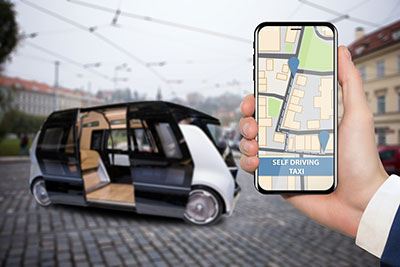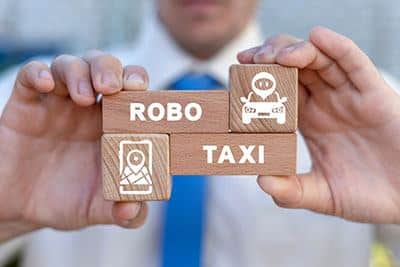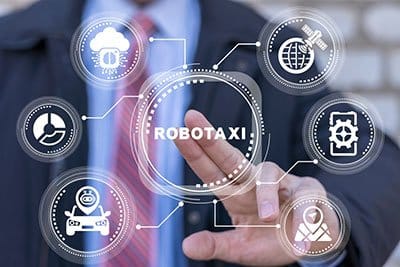Are you a parent looking to be on the cutting edge of car technology? Are you interested in knowing whether self-driving "robo-taxis" will have appropriate car seats for your little ones anytime soon?
In this comprehensive guide, we will discuss the current developments and likely advancements allowing parents to stay connected with new technology, ensuring their child is safe and secure during their journey.
So get ready for all the intel regarding will robo taxis have car seats in them with safety features benefitting both young passengers and parents.
More...
Take Away Key Points:
Robo taxi services & child car seats: To be or not to be?
If you want to know if the robotaxi service might include child car seats for transportation, read the guide below.
We have researched a bit and included crucial information for further development in autonomous cars. You will also find all about safety standards in the driverless robotaxis.
1. What is a robotaxi service?

A robotaxi service, also famous as a driverless taxi or self-driving taxi, is an autonomous car (SAE automation level 4 or 5) operated for a ridesharing service.
Robotaxis are self-driving vehicles that use artificial intelligence and sensors to navigate roads and traffic without needing a human driver. They can pick up passengers and transport them to their designated destination safely and efficiently.
Robotaxis are expected to revolutionize the transportation industry by providing a more efficient, cost-effective way of getting around.
2. Does a robo-taxi include a steering wheel?
Robo-taxi vehicles are the future of transportation. These self-driving cars are operated by an on-demand mobility service and provide a safe and secure ride for passengers.
The most notable feature of a robo-taxi is that it does not include a steering wheel, as the car is completely autonomous. Instead, the vehicle's interior is designed to be comfortable and spacious, with plenty of room for passengers to relax during their journey.
Additionally, many robo-taxi models come equipped with features such as Wi-Fi, USB ports, and even entertainment systems in front seats. So, the vehicle drives on the AI on the street, and it's moving slowly to complete Level 4 of autonomy.
The exterior of a self-driving robo-taxi looks much like any other car on the road today. However, they may have additional sensors or cameras mounted on the roof or sides to help them navigate their environment safely. Robo-taxis also come in various colors and styles to suit different tastes.
Robo-taxis offer a convenient way for people to get around without worrying about driving themselves or parking in tight spaces. They are becoming increasingly popular in cities worldwide due to their safety features and ability to reduce traffic congestion.
As AI continues to improve, we can expect robo-taxi service to become even more commonplace in the near future.
3. What is the car seat policy for driverless cars?
Robotaxis are self-driving cars that provide rides to passengers. To ensure the security of all passengers, it is important to follow the car seat policy for the driverless car service.
Waymo One, a public service provider for driverless car models, requires that children should always be secured in the appropriate child seat while riding in a Waymo One vehicle.
Baidu's autonomous vehicles can now operate without a safety driver, but there are limits on the permits for driverless vehicles. GM's robotaxi service area is open to paying customers, and they have taken measures to ensure safety in driverless vehicles.
Cruise is also marketing robotaxis as it expands its autonomous vehicles beyond Silicon Valley. Argo AI and Lyft have launched a commercial robotaxi service in Austin with safety operators present in fully driverless vehicles.
Amazon company has successfully tested self-driving robotaxis on public roads in different traffic situations. Beijing city has loosened its rules for Baidu Apollo Go and Ponyai's robo-taxis, self-driving cars, and app access.
Overall, these companies are taking measures to ensure passenger safety by implementing car seat policies for their respective robo-taxi services.
However, mass production must follow these policies when riding in a robo-taxi so that passengers can enjoy a safe ride experience in self-driving cars to their drop off locations.
4. Safety regulations for the autonomous taxi service
Robo-taxi services are becoming increasingly popular as the technology for autonomous vehicles continues to develop. Safety regulations for these services vary from country to country.
But in general, they involve testing and ensuring that the driverless cars are equipped with the necessary sensors, cameras, and software to detect and respond to potential hazards on the road.
Additionally, many countries require that a human operator be present in the vehicle at all times to take control if needed. They can protect a human driver when operating on the street.
In the United States, federal regulations have yet to be established for self-driving cars, so it is up to individual states and companies to create their safety protocols.
For example, Argo AI and Lyft have launched a commercial robo-taxi service in Austin which requires safety operators to be present in each vehicle.
Similarly, China has issued two licenses for robot taxi operations which require that Level 4 autonomous vehicles have an emergency stop button or other means of manual override available at all times. Thus, autonomous vehicles will prevent accidents involving human drivers and other passengers.
Overall, safety regulations for driverless cars are designed to ensure that passengers can travel safely while also protecting pedestrians and other human drivers on the road.
As autonomous vehicle technology continues to evolve, these regulations will likely become more stringent as governments work towards creating a safe environment for everyone involved in the autonomous taxi service.
5. Do self-driving vehicles include child restraints in the back seats?

Various robo-taxi companies currently come with rear-facing car seats in the back seat. However, some companies are exploring the possibility of providing convertible and booster car seats for children shortly.
For example, Baidu has received approval to run an autonomous taxi service that includes safety drivers and child car seats.
Additionally, Amazon is testing a robo-taxi design that features two bench seats facing each other and bus-style doors on both sides without the safety driver. The company performs additional free rides to various cities - San Francisco, etc., and the testing results are promising.
Waymo plans to improve their testing experience without safety drivers and place child car seats during the testing rides.
The Zoox company plans to exclude the test driver for the hybrid city-highway vehicle models. The company wants to invent vehicles suitable for transport between cities, with a wide range of security features for other drivers and passengers on the roads.
The main objective is to design the app operating the driver and driving to the designated destinations for ride-hailing services. The AI driver will cruise, drop off the passengers, and return to the starting point.
However, the range of features and ride-hailing will not be available for quite some time in the area of San Francisco and other cities until the company proves the driving point is safe enough for all rides.
Security tips when you're around the AI drivers
Self-driving vehicles are becoming increasingly popular, and with that comes the need to understand the security tips associated with them.
To ensure a safe experience when using self-driving vehicles, it is important to be aware of your surroundings and pay attention to the vehicle's sensors and cameras.
Additionally, it is important to anticipate the behavior of other drivers, drive conservatively around cyclists, look at the driver and the road ahead, and be aware of any potential obstacles or hazards.
Finally, it is important to ensure your vehicle has been tested thoroughly to ensure its security.
So, is it safe to place a child car seat inside the self-driving models?
As robo taxi services become increasingly popular, there is an option to select the type of seat you need when ordering a ride. It's important always to consider your child's security standards when utilizing any form of transportation, whether in your car, a robo taxi, or an autonomous vehicle.
Even though California laws don't state what age children should graduate from five-point harnesses to less restrictive car seats, it's best practice to err on the side of caution and not rush a child into moving along. Each time you choose a less restrictive child car seat, you are decreasing the level of security for your child.
Statistics conducted by various security experts have revealed that car crashes are the leading cause of death for children aged between three and fourteen years old. In addition, over 67% of these fatalities are due to drivers under the influence of drugs or alcohol.
Therefore, it's necessary to take extra caution when selecting car seat options when using self-driving taxis due to potential hazards posed by other drivers on the road.
While progress is being made in making autonomous vehicles as safe as possible, there will still be concerns about different drivers' behavior on public roads.
So, parents must take extra precautions to ensure their little ones will be safe and sound on the road or inside the driverless vehicle models.
FAQs
What city has robo taxis?
Robo taxis have been spotted in several cities worldwide, including San Francisco, Beijing, and Austin.
Waymo has been offering a Robo Cab Service in San Francisco since 2018, while Baidu operates its fleet of robo-taxis in ten cities across China. Argo AI's robotaxis are officially available via Lyft in Austin.
How much will robotaxis cost?
Robotaxis are still in the early stages of development, so it is difficult to say exactly how much they will cost. However, some companies such as Uber have already announced plans to launch robotaxis later this year, and prices will likely be competitive with traditional taxi services.
Additionally, many companies are investing in AI vehicles and are working on ways to reduce costs for consumers. It is expected that over time, the cost of robotaxis will become more affordable as the design and technological developments improve.

Will robo taxis have car seats in them?
Yes, Robo Taxis will have car seats in them shortly. Most Robo Taxis are designed to be fully AI-operated vehicles that can transport passengers from one location to another.
The cars typically have four or five seats, including the driver's seat, and are equipped with safety features such as airbags and seatbelts.
Additionally, some Robo Taxis may also include extra features such as Wi-Fi access and entertainment systems.
Final thoughts
So, what do you think? Would you like to try to ride in self-driving motor vehicles around San Francisco and other cities in the future with your little ones?
Although giant companies still test their products, the first patents are more than ready for the official launch to pick and drop off the first passengers with children and car seats.
So, if you're excited about further development, follow the official policies to find will robo taxis have car seats in them.
